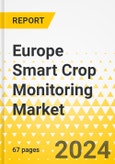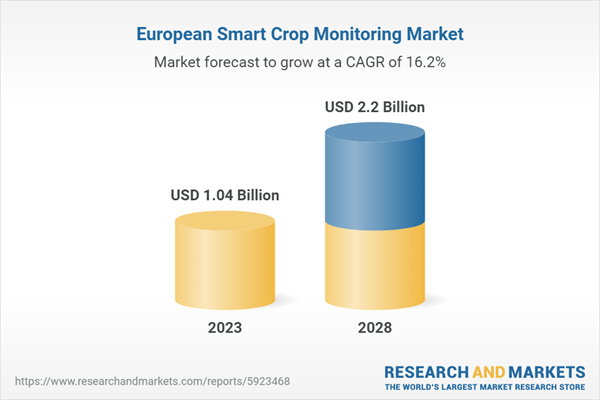10% Free customization
Introduction to Europe Smart Crop Monitoring Market This report comes with 10% free customization, enabling you to add data that meets your specific business needs.
The Europe smart crop monitoring market (excluding U.K.) was valued at $1.04 billion in 2023, and it is expected to grow with a CAGR of 16.18% during the forecast period 2023-2028 to reach $2.20 billion by 2028. The increasing demand for optimum crop yields and effective resource usage in agriculture is projected to fuel the expansion of the crop monitoring market. Furthermore, developments in technologies such as AI, machine learning, and remote sensing are projected to drive crop monitoring growth even further.
Market Introduction
Smart crop monitoring is the use of advanced technology such as satellite images, drones, sensors, and data analytics to precisely and efficiently monitor and manage agricultural crops. It entails collecting, analyzing, and interpreting data in real time to optimize many aspects of farming such as irrigation, pest management, fertilizer use, and general crop health. Crop health monitoring enables farmers to make more informed decisions, increase productivity, conserve resources, and implement sustainable agricultural methods, resulting in higher yields and lower environmental impact.Smart crop scouting and spraying have enormous promise for input optimization and increased crop yields. Farmers may ensure that pesticides and herbicides are used efficiently and effectively by spraying them more precisely, avoiding waste and even improving crop yields.
In response to these problems, demand for smart agricultural monitoring is projected to rise. These technologies can offer farmers with real-time data on crop health and soil conditions, allowing them to apply inputs more precisely and at the right moment. This saves waste while simultaneously improving crop health and production.
Market Segmentation:
Segmentation 1: by Application
- Disease and Pest Detection
- Nutrient Management
- Weed Management
- Crop Insurance
- Others
Segmentation 2: by Product
- Sensor Technology
- Drones
- Robots
- Handheld Devices
- Software and Mobile Applications
Segmentation 3: by Country
- Germany
- France
- Italy
- Spain
- Netherlands
- Belgium
- Switzerland
- Rest-of-Europe
How can this report add value to an organization?
Product/Innovation Strategy: In the realm of smart crop monitoring, technological advancements are transforming agricultural landscapes. Smart crop monitoring solutions utilize diverse technologies such as IoT sensors, drones, and data analytics. These tools offer precise insights into crop health, optimizing irrigation, pest management, and harvest times. Innovations such as satellite imaging and remote sensing provide a holistic view of fields, empowering farmers to make informed decisions. The market encompasses a range of solutions, from real-time monitoring platforms to AI-driven predictive analysis, enabling farmers to enhance productivity and reduce resource wastage significantly.Growth/Marketing Strategy: The Europe smart crop monitoring market has witnessed remarkable growth strategies by key players. Business expansions, collaborations, and partnerships have been pivotal. Companies are venturing into global markets, forging alliances, and engaging in research collaborations to enhance their technological prowess. Collaborative efforts between tech companies and agricultural experts are driving the development of cutting-edge monitoring tools. Additionally, strategic joint ventures are fostering the integration of diverse expertise, amplifying the market presence of these solutions. This collaborative approach is instrumental in developing comprehensive, user-friendly, and efficient smart crop monitoring systems.
Competitive Strategy: In the competitive landscape of smart crop monitoring, manufacturers are diversifying their product portfolios to cover various crops and farming practices. Market segments include soil analysis tools, disease detection systems, and climate analysis solutions. Competitive benchmarking illuminates the strengths of market players, emphasizing their unique offerings and regional strengths. Partnerships with research institutions and agricultural organizations are driving innovation.
This product will be delivered within 3-5 business days.
Table of Contents
1 Markets
2 Region
3 Markets - Competitive Benchmarking & Company Profiles
4 Research Methodology
List of Figures
List of Tables
Companies Mentioned
- CNH Industrial N.V.
- AGRIVI
- Robert Bosch GmbH
- Airbus
- Small Robot Company
Table Information
| Report Attribute | Details |
|---|---|
| No. of Pages | 67 |
| Published | January 2024 |
| Forecast Period | 2023 - 2028 |
| Estimated Market Value ( USD | $ 1.04 Billion |
| Forecasted Market Value ( USD | $ 2.2 Billion |
| Compound Annual Growth Rate | 16.1% |
| Regions Covered | Europe |
| No. of Companies Mentioned | 5 |









